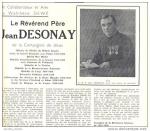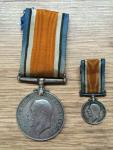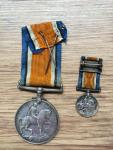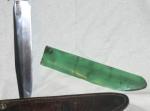-
Posts
29,251 -
Joined
-
Last visited
-
Days Won
84
Content Type
Profiles
Forums
Blogs
Gallery
Events
Store
Everything posted by Chris Boonzaier
-
Yes indeed... I specially like the austrian one...
-
Hi, He also seems not to have recieved a Belgian Croix de Guerre. Maybe because the Networks were working for British Military Intel that the Belgians were miffed. he did get the Evader 1940-44 wich I guess was people who evaded from Belgium with the huns on their heels... but once again, he was serving the Brits not the Belgians...
-
Father Jean Desonay was born in Soumagne on the 9th of August 1886. At the outbreak of the war he was a professor at the Jesuit collège Saint-Servais in Liège. In 1914, as he would do in 1939, Jean Desonay was involved as an agent from day one. Desonay’s activities at the outbreak of the war were not limited to his membership in the intelligence gathering network “réseau Lambrecht” but he was also involved in with underground press, smuggling letters from occupied Belgium to the Belgian soldiers fighting with the allies as well as helping people escape from occupied Belgium. Dieudonné Lambrecht was a Belgian civilian who set up a network of agents who amongst other things monitered German Railway movements. The information was of great use to the Allied High command and was communicated via neutral Holland. Lambrecht was betrayed, tried then executed in April 1916. 3 000 people attended his Funeral. His network was taken over by Lambrecht’s cousin, Walthère Dewé. Along with the Jesuit Priest Jean Desonay (who had been one of Lambrecht’s right hand men) and an engineer named Chauvin he set out to rebuild and improve the organization. He renamed it “La Dame Blanche” based on a German legend that the appearance of a woman wearing white would signal the collapse of Hohenzollern. They organized the réseau along Military lines with battalions, companies, and independant cells. There were groups responsible for observing German troop movements by rail, by road and for transmissions. The betrayal of Lambrecht to the Germans had taught them the value of secrecy within the network and the cell system would mean that agents would not be able to betray the network. Father (père) Desonay (Code name “Commandant Belleflamme” ) was betrayed and arrested on the 14th of June 1917. The Police knocked on the door of his classroom but were persuaded to let him finish his lesson. Desonay used the time to give a student his papers, including secret communiques. The student passed the documents on to the head of the school. Desonay was interrogated numerous times but the Germans were not able to establish his guilt. While other members of networks were executed or condemned to do forced labor, Desonay was sent to a camp for “undesirables” near Holzminden. At the time of his arrest the most important work of the réseau la Dame Blanche was still to come but Desonay had been instrumental in organizing the network with its over 1 000 agents. The British War office was to commend the members of the Dame Blanche crediting them with having reported 70% of the intelligence that the Allies received from occupied and neutral countries. Douglas Haig claimed the information received was essential for planning his operations. On the 3rd of September 1939 Walthère Dewé assembled his “old Guard” … Chauvin, Desonay etc. and reactivated the Dame Blanche Network… The network would carry out sterling work throughout the war relaying information back to London. Walthère Dewé was killed by a German officer in 1944. It was decided that Father Desonay’s WW1 service was known to the Germans and he was considered to be too well known to operate effectively in Belgium. He was sent to the Vichy “Free Zone” in Southern France where he was involved with escape networks for Allied Aircrews evading after being shot down over Europe. Using the Nom de Guerre “Pere de Fromenteau” his cover was as a teacher at the Jesuit college du Caousou in Toulouse. He operated here until he was once again betrayed and then had to flee across the mountains into Spain. After a while in Portugal he made his way to England where he spent the rest of the War. He returned to Belgium after the war where he died in 1948. Amongst his other medals he was awarded the Order of the British Empire, The French Croix de Guerre with Palm, British War Medal, Medaille Commemorative de la Guerre 1914 – 1918 avec Couronne de Volontaire, Medaille de la Victoire, Medaille de la Reconnaissance Nationale, prisonnier Politique 1914-1918.
-
Hallo, No, I ask this question out of interest for a number of reasons. I have no idea if your jacket is good or not, so I ask questions. 1) Anytime anyone posts a GERMAN jacket with these insignia, even there questions are raised. Anytime anyone posts a GERMAN jacket with SS insignia, questions are raised. If we did not question in this hobby we would all be out of pocket. 2) Dutch field grey I assume is like Swedish field grey. I cut up swedish field grey to make backings for frames... I am sure if there was a way to "Germanise" Swedish Field Grey, people would be doing it. That being the case... how easy is it to Germanise Dutch stuff? Pretty easy. 3) There is no shortage of Foreign volunteer shields on the market, more shields than buyers. 4) I have a 9 year old son who goes through clothes like crazy... patches on his jeans have wear and fading within weeks. 5) I thank you for posting it and hope you do in fact have a rare and desirable jacket, but as before, rare tunics, be they SS or foreign Volunteers, are never a case of "This is my jacket, don't question, just believe"
-
Just incase our Belgian collectors miss this.... http://gmic.co.uk/index.php/topic/63733-belgian-agent-bwm-cream-of-the-crop/#entry600840 Find of the month I think ;-)
-
What is the green bit of plastic i hear you ask... or not..... I prefer the carbon steel blades to stainless steel.... After a very wet time in Central Africa the leather was constantly wet, so I made a sheath liner out of a plastic mountaindew bottle, cut the shape, folded it and slid it into the sheath. I also removed the sharpening stone pouch, it made it easier to slide the sheath under straps or under a belt.
-
Have not had these out in many a year..... One is a 8 Inch Randall No1, the other is a Randall No14. My first No 1 was so mint, out of the box, I literally closed my eyes, and hacked at a chunk of wood 4-5 times... just to pop its cherry.... I had this No1 for 4 years in the army... it was really used and abused... and is thill here... around me guys were breaking their K-Kars in all directions.... The No14 was simply and purley a toy i could not afford. I bought it years after leaving the army, and actually have more knives than I will ever need, and seldom if ever need one... but the No14 for me is the best knife ever... so i traded a bunch of stuff for it.... The Handle and sheath on the No1 used to be the same color as the sheath on the no14....
-

Great Britain F-S dagger
Chris Boonzaier replied to gregM's topic in Great Britain: Militaria: Badges, Uniforms & Equipment
Mine is a late 80s one... I remember at a show back in 1994, a Named Vietnam era Randall Nr 1 for CDN $ 200... I was broke and could not afford it.... I still regret that :-( -

Great Britain F-S dagger
Chris Boonzaier replied to gregM's topic in Great Britain: Militaria: Badges, Uniforms & Equipment
I slit plenty of throats with my Randall Nr 1... of course... they were goats.... but an 8 Incah Randall Nr1 is gods gift to knives ;-) -

Great Britain F-S dagger
Chris Boonzaier replied to gregM's topic in Great Britain: Militaria: Badges, Uniforms & Equipment
Optically one of the nicest knives around. I love them to bits. Practically about as useful as an empty box with holes in it. I had one on my web gear for a couple of days as a just out of basic traing soldier.... but a man can only stand so many sniggers and chuckles.... and when I realised others could open tins, but wood and "do stuff" with their knives... and I would have to wait 10 lifetimes or more to find the sentry i could kill with mine... it dissapeared back into the trunk... I guess it is best for what it was designed for... a WW2 commando. Having said that, a classic, and beautiful....












